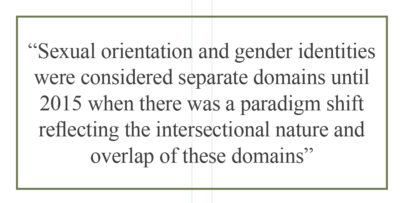The Interface of the Sexualities and Gender Variations
The sexualities, sexual orientation, range from heterosexual, bisexual, pansexual, same-sex (lesbian, gay) and asexual. Gender may be binary (male, female), agender or outside the binary i.e. transgender, non-binary or genderqueer. The notion that one’s sexual attraction to another individual extends across all diverse genders is not a new concept. There exists an inseparable interface between sexual orientation and gender variations.
Historically, sexual orientation and gender identities were considered separate domains until 2015 when there was a paradigm shift reflecting the intersectional nature and overlap of these domains (APA published letter in NIH:https://www.apa.org/science/about/psa/2015/12/sexual-gender-minorities.pdf.
 One’s sexual and gender identity is intersected by a number of factors such as racial, ethnic, sociocultural, linguistic, educational, psychological and psychiatric history, one’s familial differences and need to be accounted for within any interaction (Hymel, Lasky, Crowell, et al., 2018; Okoro, Hillman, & Cernasev, 2020). When all these aspects of the individual are not considered, disruptions and potential negative effects on accessing healthcare influences outcomes of care (Cyrus, 2017; Shangani, Gamarel, & Ogunbajo, 2020). Healthcare disparities and inequities among sexual and gender minorities may result.
One’s sexual and gender identity is intersected by a number of factors such as racial, ethnic, sociocultural, linguistic, educational, psychological and psychiatric history, one’s familial differences and need to be accounted for within any interaction (Hymel, Lasky, Crowell, et al., 2018; Okoro, Hillman, & Cernasev, 2020). When all these aspects of the individual are not considered, disruptions and potential negative effects on accessing healthcare influences outcomes of care (Cyrus, 2017; Shangani, Gamarel, & Ogunbajo, 2020). Healthcare disparities and inequities among sexual and gender minorities may result.
Within the patient-provider dynamic we strive for clinical partnerships, where shared decision-making result and lead to potentially positive outcomes (Tervalon & Garcia (1998; Bukstein, Guerra, Huwe et. Al, 2020). This type of approach will produce quality patient-provider interactions and ultimately result in less health disparities and inequities. Ongoing training and education in sexual and gender health while incorporating intersectional identities is vital in promoting best practices (Foronda et al., 2018; White & Stubblefield-Tave, 2017). Training needs to include the acquisition and internalization of skills and strategies that shape provider knowledge and behavior (Thomas & Booth-McCoy, 2020) and incorporate aspects of humility, self-reflection, and partnering (Gonzalez et al., 2021) can result in increased sensitivities within sexual and gender health.
